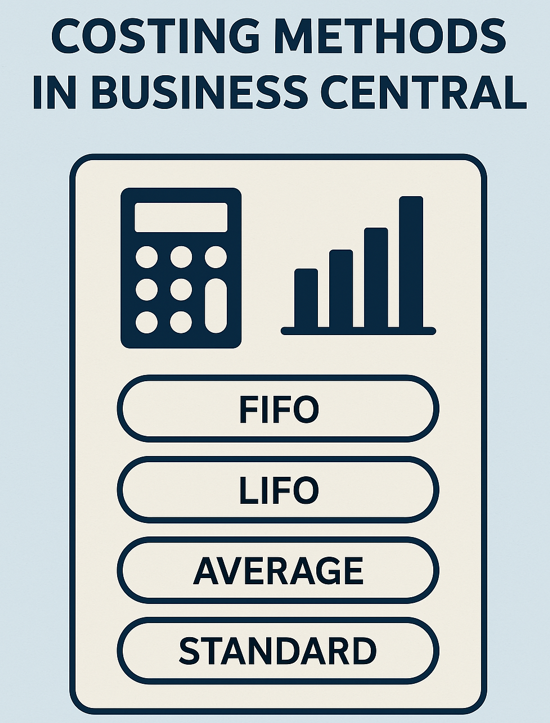Costing Methods in Dynamics 365 Business Central
In Dynamics 365 Business Central, the costing method is a critical setup that directly impacts how your system calculates Cost of Goods Sold (COGS) and inventory valuation. It’s not just an accounting setting—it influences your profitability, pricing decisions, and financial reporting accuracy. Choosing the right costing method ensures your books reflect reality, supports better business decisions, and keeps you compliant with tax laws and accounting standards. Costing methods in accounting.
Setting Up Costing Methods in Business Central
To configure the costing method in accounting (Business Central), follow these steps:
- Open the Item Card
Use the search bar in Business Central and type “Items”. Select the item from your list to open its Item Card, where detailed configurations are managed. - Assign the Costing Method
On the Item Card, locate the “Costing Method” field. Here, you assign the method that determines how Business Central calculates both your inventory value and COGS. The available options are:- FIFO (First In, First Out)
- LIFO (Last In, First Out)
- Average Cost
- Standard Cost
- Specific Cost
Important Note:
Once you’ve posted transactions for an item, you cannot change its costing method without complex adjustments. This is why it’s essential to set it correctly from the start—consult your finance or accounting advisor if needed.
Why Costing Methods Matter
Impact on Cost of Goods Sold (COGS)
Your selected costing method determines which inventory costs are applied when you sell items. This affects your gross profit and can significantly alter your financial statements, especially in industries with fluctuating prices. For example, FIFO might result in lower COGS when prices are rising, leading to higher reported profits, while LIFO may produce the opposite effect. Costing methods in accounting.
Impact on Inventory Valuation
Inventory value appears as an asset on your balance sheet. Using FIFO during inflationary times may overstate your inventory value, whereas LIFO could understate it. Average cost smooths out fluctuations by spreading costs evenly. The valuation directly affects your financial health indicators and can influence decisions on loans, taxes, and stakeholder reports.
Influence on Business Decisions
Costing isn’t just about numbers in your ledger—it directly informs pricing strategies, budgeting, tax planning, and inventory management. If your COGS calculation method doesn’t align with your business reality, it could lead to misguided decisions. For example, manufacturers might prefer Standard Cost for predictable costing, while retailers with fast-moving items may choose FIFO.
Understanding Costing Methods in Dynamics 365 Business Central
In Microsoft Dynamics 365 Business Central, costing methods define how the system calculates inventory valuation and cost of goods sold (COGS) for each item you manage. This choice affects financial reporting, tax calculations, pricing strategies, and profitability analysis. Let’s break down each method in detail so you can see how they function and when to use them. Costing methods in accounting.
1. FIFO – First In, First Out
FIFO (First In, First Out) assumes that the oldest inventory items purchased are the first ones sold. This method mirrors the natural flow of many businesses, especially those dealing with perishable goods, food products, or items with a shelf life.
How FIFO Works:
- When you sell a product, the system deducts the cost of the oldest inventory first.
- If prices are rising over time, FIFO results in lower COGS and higher reported profits.
- Inventory on hand is valued at the most recent purchase cost.
For Example:
- Purchase 100 units @ ₹10 each
- Purchase 100 units @ ₹15 each
- Sell 150 units
COGS Calculation:
- 100 units × ₹10 = ₹1,000
- 50 units × ₹15 = ₹750
Total COGS = ₹1,750
Remaining Inventory: 50 units @ ₹15 = ₹750
Best For:
- Retail businesses
- Food industry
- Pharmaceuticals
2. LIFO – Last In, First Out
LIFO (Last In, First Out) assumes that the newest inventory purchased is sold first. Though not allowed under IFRS (and not typically used in India), some companies may use it under certain reporting standards.
How LIFO Works:
- The most recent costs are assigned to COGS.
- In times of rising prices, LIFO leads to higher COGS and lower taxable profits.
- Inventory on hand is valued at older, often lower costs.
For Example:
- Purchase 100 units @ ₹10 each
- Purchase 100 units @ ₹15 each
- Sell 150 units
COGS Calculation:
- 100 units × ₹15 = ₹1,500
- 50 units × ₹10 = ₹500
Total COGS = ₹2,000
Remaining Inventory: 50 units @ ₹10 = ₹500
Best For:
- Industries dealing with commodities or materials with fluctuating prices
3. Average Cost
Average Costing applies a weighted average of all inventory costs, spreading cost fluctuations evenly across all items.
How Average Cost Works:
- Every time new inventory is received, a new average cost is calculated.
- COGS and inventory valuation are both based on this average.
- Smoothens out price fluctuations.
For Example:
- Purchase 100 units @ ₹10 = ₹1,000
- Purchase 100 units @ ₹15 = ₹1,500
- Total Inventory = 200 units, Total Cost = ₹2,500
Average Cost = ₹2,500 ÷ 200 = ₹12.50 per unit
- Sell 150 units
COGS = 150 × ₹12.50 = ₹1,875
Remaining Inventory = 50 × ₹12.50 = ₹625
Best For:
- Wholesale distributors
- Businesses with frequent price changes
4. Standard Cost
Standard Costing uses a fixed cost for each item, predetermined by the company. Variances between standard cost and actual purchase cost are tracked separately.
How Standard Cost Works:
- You define a standard cost for the item.
- COGS is always calculated at this standard rate.
- Variances are reported in a separate account.
For Example:
- Standard Cost = ₹12 per unit
- Sell 150 units
COGS = 150 × ₹12 = ₹1,800
If actual purchase price differs, the system records this difference as a variance.
Best For:
- Manufacturing companies
- Businesses focused on cost control and variance analysis
5. Specific Cost
Specific Costing tracks the exact cost of each individual item, often by serial number or lot number.
How Specific Cost Works:
- Each item is assigned a unique cost.
- When sold, the exact cost is used for COGS.
- Provides highly accurate tracking and costing.
For Example:
- Lot A: 100 units @ ₹10
- Lot B: 100 units @ ₹15
- Sell 50 units from Lot B
COGS = 50 × ₹15 = ₹750
Remaining Inventory:
- Lot A: 100 units @ ₹10
- Lot B: 50 units @ ₹15
Best For:
- Electronics
- Pharmaceuticals
- Aerospace
Key Insights for Dynamics 365 Business Central Users
- FIFO and Average Cost are the most widely used in India.
- Once a costing method is set and transactions are posted, you cannot change it without complex adjustments.
- Always review Value Entries in Business Central to understand how costs are calculated and posted.
- The costing method affects inventory valuation, COGS, profitability, tax reporting, and financial analysis.
Choosing the right costing method is a strategic decision that impacts every aspect of your business — from accounting compliance to pricing strategy. Make sure to align it with your industry practices, business model, and regulatory requirements. Costing methods in accounting.


